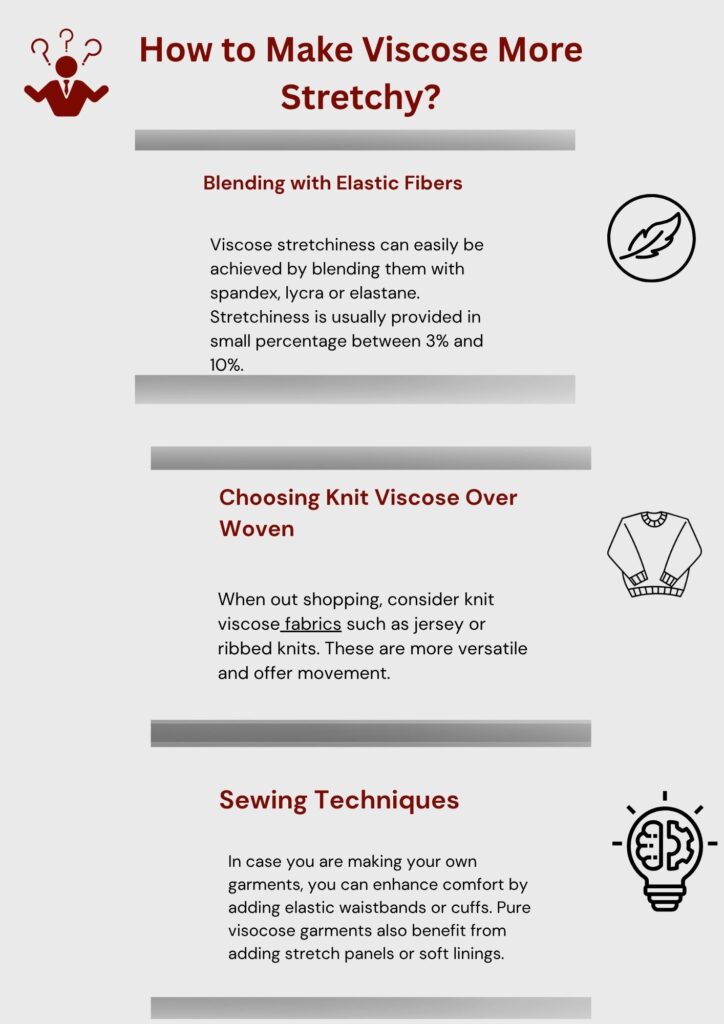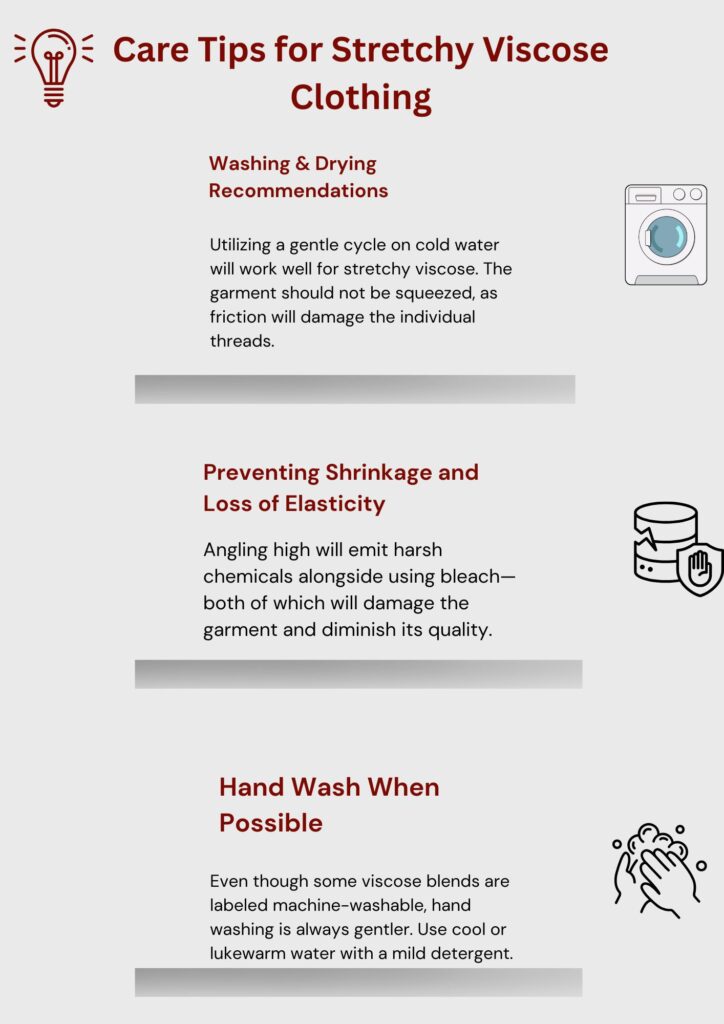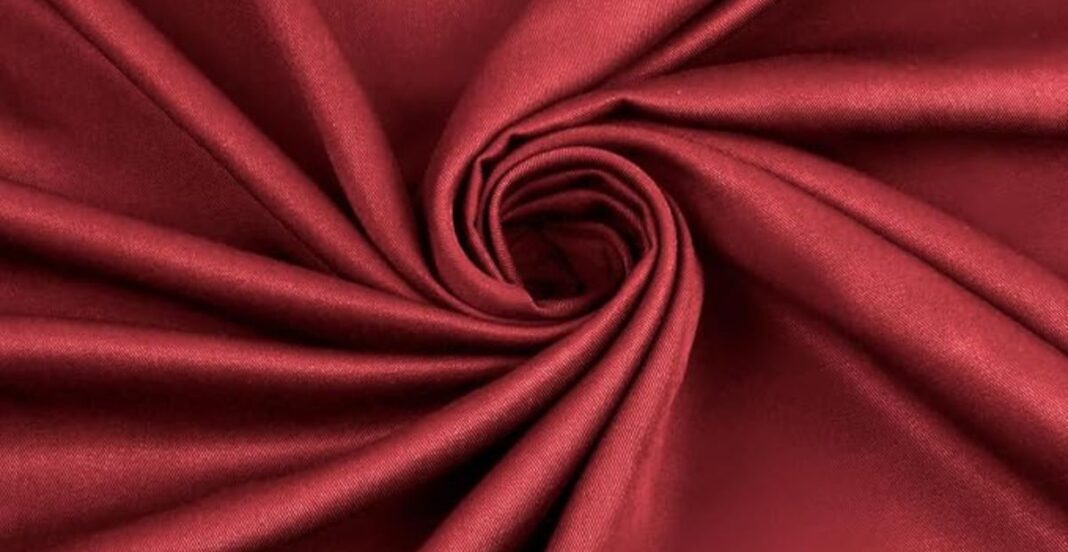Introduction
Viscose is classified as a semi-synthetic fiber, with origins as a regenerated cellulose derived from wood pulp. It is important to note that even though viscose comes from natural sources, it undergoes extensive chemical processing, thus being classified as semi-synthetic. It was first produced in the late 19th century and designed to replicate silk’s lavish texture at an affordable price.
As well as dresses or blouses, viscose can also be found in scarves. Viscose is also used in home textiles as curtains and as upholstery on furniture because if its soft drape. It offers both comfort and breathability in wearing garments hence why it is popular all year round.
Due to the elasticity some fabrics have, the question, “Is viscose stretchy” comes up. Some clothes may be figure-hugging, while other times appear baggy. A combination of several reasons contribute to this change, which we will discuss below.
Is Viscose Stretchy? (Direct Answer)
To put it simply, no, pure viscose does not have any natural stretch to it. It can do to an extent because of its weave but this is not comparable to stretching that happens with garments containing spandex or elastane. Viscose, however, can become stretchable if blended with elastic fibers. For comfort and flexibility, manufacturers tend to add spandex to make the garment more comfortable.
Compared to other textiles, viscose is lower ranked when it comes to natural elasticity. For instance, cotton has more natural give than pure viscose. While somewhat stretchy, polyester is also mess durable; on the other hand, spandex and lycra have a high elongation value. When blended with these, viscose acquires stretch properties that are perfect for fitted garments.
While shopping, if you find yourself asking, “Is viscose stretchy enough for tight fitting clothes?”, then look for tags with additional stretch fibers.
Factors Affecting Viscose Stretchiness
Pure Viscose vs. Blended Viscose
Loose-fitting clothes made of pure Viscose have minimal stretch due to the fabric’s lack of elasticity. Blended viscose—especially with 5–10% spandex or elastane—flexible fit. Blends are better for body hugging clothes like leggings or fitted tops
Weave & Knit Type
Viscose fabric can be either woven or knitted. Woven viscose holds its shape well but has almost no stretch. Knit viscose, especially jersey knit, is much more flexible. Knitted structures provide a greater range of natural movement and recovery which is more comfortable during wear.
Fabric Treatment
Some stretchy viscose fabrics undergo softening chemical treatments. Finishing techniques rispurs such as enzyme washes or application of heat enhances looks and feel of the fabric. Without the inclusion of elastic fibers, these methods do not significantly improve stretch.
How to Make Viscose More Stretchy?

Blending with Elastic Fibers
Viscose stretchiness can easily be achieved by blending them with spandex, lycra or elastane. Stretchiness is usually provided in small percentage between 3% and 10%. Fabrics are also more durable to frequent use with this combination.
Choosing Knit Viscose Over Woven
When out shopping, consider knit viscose fabrics such as jersey or ribbed knits. These are more versatile and offer movement. Unlike woven viscose which is stiff, knits are soft and easy, which makes them great for casuals.
Sewing Techniques
In case you are making your own garments, you can enhance comfort by adding elastic waistbands or cuffs. Pure visocose garments also benefit from adding stretch panels or soft linings. Joining seams with zigzag stitches improves the seam’s ability to stretch without breaking.
Pros and Cons of Viscose Stretchability
Pros
Advantages and Disadvantages of Viscose Stretchability
- Drapes Beautifully: Viscose’s graceful drapes are complemented by a soft flow and soft silken hand.
- Lightweight: Great for hotter climates, Viscose is not temperature adverse.
- Soft Feel: Silky viscose is soft to the skin, making it commendable for use in sensitive applications.
- Breathable: Prevents overheating soft silks allow for air to pass through.
Cons
- Limited Natural Stretch: With no blends, viscose offers no elasticity.
- Wrinkles Easily: Without blending, pure viscose has the tendency to crease easily.
- Can lose shape: To a varying degree shrinkage or stretching may occur due to viscose’s improper treatment.
- Sensitive to water: Stretching ability and elasticity is impacts by weakness when wet, an attribute water is to viscose.
- Gentle Washing: Impairs both stretch and longevity, careless hydrating promises improper protective garments.
Stretchy Viscose vs. Non-Stretchy Viscose – How to Tell?
Reading Fabric Labels
Before buying check tags. Look around for words” elastane” “spandex” or “lycra”. Their presence merits assurance of the garment containing stretchable fabrics.
Stretch Test
A simple stretch test can help. Take a section of the fabric and gently pull it horizontally. If it returns to its original shape then likely contains elastic fibers. Viscose will feel stiff and not bounce back.
Best Stretchy Viscose Blends for Different Uses
Viscose + Spandex (5–10%)
This blend works best for form-fitting apparel such as leggings, turtlenecks, and dresses. Exercising and free movement will feel effortless due to the softness of the fabric while it retains its shape.
Viscose + Polyester
The main uses of garments made from this fabric will be blouses, as well as casual dresses. They will serve their purpose of being worn frequently without loose threads or creases thanks to viscose’s strengthening ability alongside polyester’s added benefits. The blend does provide a small amount of elasticity, but not enough in comparison to spandex blends.
Care Tips for Stretchy Viscose Clothing

Washing & Drying Recommendations
Utilizing a gentle cycle on cold water will work well for stretchy viscose. The garment should not be squeezed, as friction will damage the individual threads. Air drying is the preferred method of drying, and should be done by laying flat or hung on a padded hanger.
Preventing Shrinkage and Loss of Elasticity
Angling high will emit harsh chemicals alongside using bleach—both of which will damage the garment and diminish its quality. The stretchy viscose blend does hold its shape and feel for a longer duration when proper care is taken, such as not using high temperatures while ironing or using gentle detergents.
Conclusion
So, is viscose stretchy? No solo, but combined with spandex or knitted into flexible patterns makes it stretchable. Viscose provides options that range from structured dresses to comfy leggings.
For comfort and flexibility pick viscose blended with elastic fibers. For an elegant and stylish feminine silhouette relax fitting viscose is perfect for you. Always do the stretch test and check fabric labels before buying. With the right blend of seam and viscose, you can enjoy beauty and comfort in your garments.
FAQs
No, 100% viscose has very little elasticity. Under pressure it may deform but there will be no recovery.
Moisture causes viscose to absorb water; this results in the fabric clinging to the body. This is common during hot and humid weather.
Through the process of soaking and reshaping, you can stretch viscose fabric. However, this will only be effective for the immediate short term and will revert when washed or dried.


